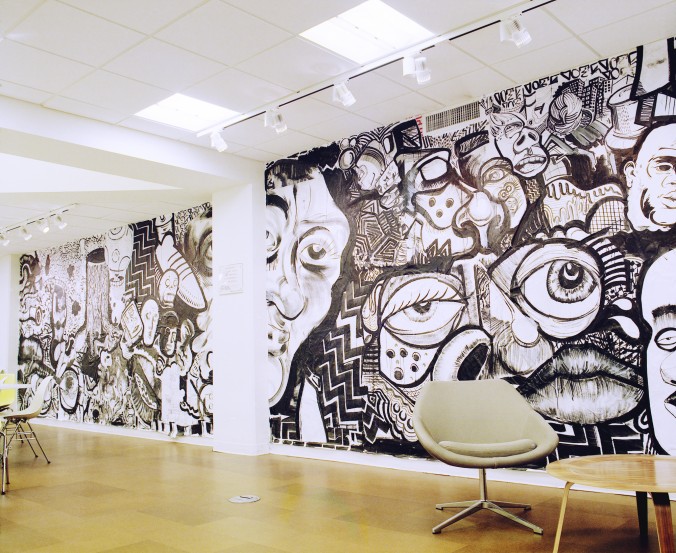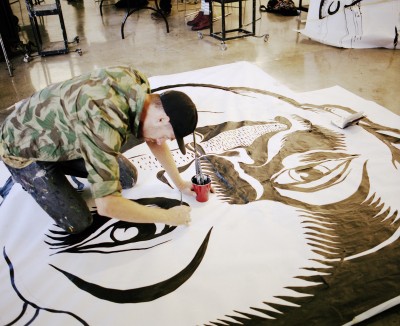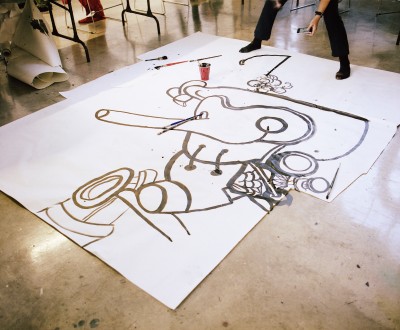
Canadian Street Art Movement Comes to SAIC
Huge black-and-white murals have suddenly sprung up across SAIC’s campus. The entrances to the MacLean Center and Columbus building, as well as the Columbus building’s second floor café, have been adorned with massive illustrated walls featuring grinning faces, organic drips, smoke-like swirls, and other assorted imagery. These murals are the result of collaborative efforts between SAIC students and faculty and a handful of Montreal-based artists as part of a project called “EN MASSE.”
Artists Jason Bodtkin and Tim Barnard started the EN MASSE project in 2009 as a way to connect visual artists from different disciplinary backgrounds through collaborative pieces. EN MASSE’s website explains, “For the most part, artists participating in the project are self-taught creative entrepreneurs. EN MASSE is a high-profile public platform for these people who have often found themselves in an awkward relationship with many contemporary arts institutions (resulting in their work often being excluded from mainstream galleries, museums, and funding agencies). This is a bridge for artist to institution, and vice versa.”
EN MASSE encompasses multiple types of projects focusing on different types of spaces and levels of public interaction, including gallery and museum installations, festivals and public events, private commissions, and pedagogical programming. SAIC’s involvement with the program falls under the last category, which EN MASSE refers to as “EN MASSE for the Masses.” The MacLean and Columbus Drive murals mark the program’s first foray into U.S.-based educational environments.
 The murals installed at SAIC are the result of involvement from EN MASSE artists as well as SAIC undergraduate students. The program was coordinated through the efforts of Rachel Kaplan from SUGs and Painting & Drawing faculty member Katherine Desjardins. Rachel explains, “I was interested in bringing [the EN MASSE] project to Chicago as a means to talk about the unique process of collaboration. I was also interested to re-create their project in a university setting where students have the opportunity to work outside the classroom and in a closer proximity to their classmates.” When Katherine was approached by Rachel about bringing the project to SAIC, she was especially excited about its role as an educational experience for students. Katherine notes, “For me, a really important aspect of the history of large-scale figuration includes not only cave paintings, but frescoed ceilings, wall paintings, and by extension, murals and graffiti culture. I always try to embed an ‘expanded’ element into the classes I teach at SAIC, so this seemed like a great opportunity for students to create large-scale drawing installations around campus, outside of the classroom.”
The murals installed at SAIC are the result of involvement from EN MASSE artists as well as SAIC undergraduate students. The program was coordinated through the efforts of Rachel Kaplan from SUGs and Painting & Drawing faculty member Katherine Desjardins. Rachel explains, “I was interested in bringing [the EN MASSE] project to Chicago as a means to talk about the unique process of collaboration. I was also interested to re-create their project in a university setting where students have the opportunity to work outside the classroom and in a closer proximity to their classmates.” When Katherine was approached by Rachel about bringing the project to SAIC, she was especially excited about its role as an educational experience for students. Katherine notes, “For me, a really important aspect of the history of large-scale figuration includes not only cave paintings, but frescoed ceilings, wall paintings, and by extension, murals and graffiti culture. I always try to embed an ‘expanded’ element into the classes I teach at SAIC, so this seemed like a great opportunity for students to create large-scale drawing installations around campus, outside of the classroom.”
 The first step in creating the murals was for all participants to create separate improvised ink drawings, which were later integrated together into the finished installations. The separate pieces were cut and trimmed and were then wheat-pasted to the assigned wall spaces in formations dictated by the sizes and shapes of the individual illustrations. Once each wall was fully covered, the remaining negative space between the drawings was filled in to create a unified mural. For Katherine, the entirety of the process was important to the overall learning experience. She explains, “This was the first time that EN MASSE had used the drawing/wheat paste/collage technique as the basis for collaborative installation … [My own work] is drawing-based and involves a collage sensibility, so I planned the all-day workshop as a moment for the class to create a ‘mass’ (literally) of ink and brush drawings on paper, for later use in the installations. The class was divided into teams, and each team took on one of the SAIC sites together.”
The first step in creating the murals was for all participants to create separate improvised ink drawings, which were later integrated together into the finished installations. The separate pieces were cut and trimmed and were then wheat-pasted to the assigned wall spaces in formations dictated by the sizes and shapes of the individual illustrations. Once each wall was fully covered, the remaining negative space between the drawings was filled in to create a unified mural. For Katherine, the entirety of the process was important to the overall learning experience. She explains, “This was the first time that EN MASSE had used the drawing/wheat paste/collage technique as the basis for collaborative installation … [My own work] is drawing-based and involves a collage sensibility, so I planned the all-day workshop as a moment for the class to create a ‘mass’ (literally) of ink and brush drawings on paper, for later use in the installations. The class was divided into teams, and each team took on one of the SAIC sites together.”

The three SAIC murals will be on view through the remainder of the fall semester, and additional EN MASSE work can currently be seen at another mural that they recently installed in Pilsen at Loomis and 16th with the help of SAIC graduate students from multiple artistic disciplines. For Rachel, the project has served as a great starting point for potential future work. “I would love to do this again in Chicago with more students at a larger scale,” she explains. “I would also love to bring in working artists — alumni perhaps — to truly explore what a highly spontaneous, diverse collaboration looks like.”
More information on EN MASSE, including images of their previous mural installations, can be found on their website: www.enmasse.info





